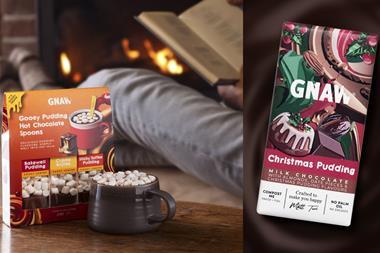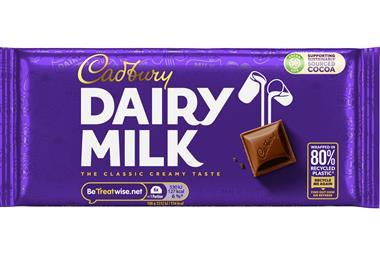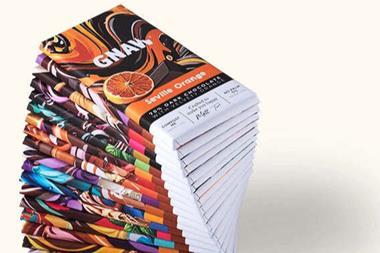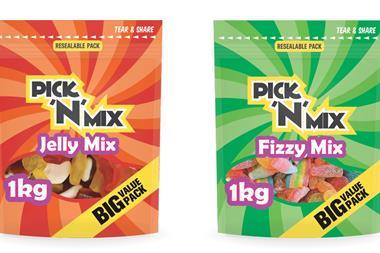The old cliché that Christmas begins earlier every year is already starting to rear its ugly head. Even though the shorts and barbecues are only just being packed away, British shoppers are now thinking about the festive season and retailers who are prepared will capitalise on this. This doesn’t mean you have to dust off the fairy lights and decorations just yet though. The early festive win for independent retailers comes from the confectionery category which grew 5.4% year-on-year, according to Nielsen. But it’s important that it’s done right.
“Christmas continues to be the shining star of the confectionery industry, year after year,” says Hancocks purchasing director Jonathan Summerley.
“Come rain or shine, growth or recession, the confectionery market is always there to boost spirits and bring smiles. It’s always there for retailers too, presenting a seasonal profit opportunity for even the smallest of stores.”
Counting down the days
Want a product that sells out a month before the big day? Then advent calendars are the product for you.
Hancock’s Jonathan Summerley says they act as a good bridge between early shopping occasions and the run-up to Christmas. “Shoppers need to be familiar with your range so that they choose to buy from you when they are ready,” he says. “While many advent calendars are purchased at the last minute, a large proportion will be bought in the weeks running up to December.”
Hancocks has two £1 advent calendars, Christmas and the Nativity Scene.
Mondelez’s Cadbury Dairy Milk Advent Calendars, available in 90g and 170g, have also been given a makeover for Christmas.
Summerley says that Christmas is resilient and not even an economic downturn could dampen the festive spirit. “Confectionery is so closely aligned with the Christmas season nowadays and we all expect to give and receive some sweet treats,” he says. “Having reliably delivered gifting affordability throughout the recession, we’ve come out the other side with a strong habit of choosing confectionery for gifts. Not just for family either. Shoppers choose token confectionery gifts for neighbours, colleagues, teachers, dog-walkers - you name it!”
Levi Boorer, customer development director at Ferrero, says the season is a key part of the year for retailers but they should exercise caution.
“The Christmas season accounts for 39% of confectionery sales,” says Boorer. “97% of people buy Christmas confectionery and the average consumer buys from the category 14 times in the run up to Christmas.”
Boorer has two pieces of advice for retailers looking to make the most of confectionery at Christmas. Firstly, he urges against overstocking in the category.
“Try not to focus on stocking too much NPD and trust in the core range,” he says. “It’s not about trying to stock everything that’s new, that’s too high risk for an independent retailer. They should be prioritizing the core range and there’s no need to mess with a winning formula.”
He also warns against getting caught up in a price war that may be impossible to win. “Don’t get bogged down in the promotional frenzy,” says Boorer. “You’ll see promotions that you just can’t compete with so try to avoid listing the products such as tins that you can’t compete with on price.”
Summerley agrees and offers up a solution to the price war. “Shoppers want to buy tins as family gifts for Christmas but they don’t always want to buy the same ones,” he says. “Retailers want to sell tins at Christmas but not priced at more than the supermarkets, given that the big chains use tins as a battle ground. Our solution has been to develop a different and exciting range of unbranded tins that shoppers will enjoy using after Christmas too, making them delicious and better value overall.”
Donna Morgan of Brownlies of Biggar in Lanarkshire, Scotland, agrees that it’s difficult to try and match the multiples on price. “We sell tins of Quality Street and Celebrations but not as many as we used to as the multiples discount them so heavily and we simply can’t compete with that, so sales of selection boxes and tubs have declined over the years,” she says.
“Instead, we do a smaller standard range and stock other products that our competitors don’t have. Impulse is big for us and is a great way to start the season. As we move closer to Christmas, we create a larger boxed chocolate display as customers are more ready for it.”
Looking back
Old is the new new as confectionery manufacturers capitalise on nostalgia
Retro is in this year and while that doesn’t mean that retailers should drag their flares out of storage just yet, they should be looking at the products of yesteryear for inspiration.
Bonds Confectionery managing director Philip Courtenay-Luck says old is the new new. “The demand for retro confectionery products is ever growing,” he says. “Vintage and retro lines across all ranges have become increasingly popular over the past few years, with many companies reverting to old packaging designs, like the Keep Calm and Carry On slogan.”
He believes it’s being driven by nostalgia. “Bonds appeals to an older audience using this vintage idea as a reminder of childhood and gives consumers nostalgia when eating its products,” he adds.
“Products use traditional packaging to further this vintage/retro theme. Bonds jars and traditional Sweet Shop range are ever popular with the growing trend, along with Retro Bag containing classic products such as Wham chews and Palma Violets.”
Swizzels is also looking back this Christmas with its festive range. Its Sweet Shop Favourites tin and Sweet Extravaganza make a return, while the Drumstick, Love Hearts and New Refreshers gift tubes have a new look. New in 2014 are the Parma Violet and One Direction Love Hearts gift tube.
Harj Dhasee of the Village Stores (Nisa) in Mickleton, Gloucestershire, says this factors into his ordering for seasonal items. “We only buy in products that we are able to pricematch the multiples on,” he says. “It helps give the impression that we’re as competitive as them. There’s no point in getting a load of stock in that customers will find at a better price elsewhere, you’ll just be left stuck with it.”
What timing
As usual, retailers are faced with the debate of when they should start putting out their Christmas stock. After all, it’s crucial you get the timing right and walk that fine line between too early and too late.
Adam Hogwood, of Morrison’s Budgens of Broadstairs in Kent, says planning is already underway for Christmas. “We’re looking at last year’s layout at the moment and getting a plan in place which includes locations ready for tubs, general confectionery and hods,” he says. “The rest will be ‘ad-libbed’ around other promotional activity going on at the time.”
Mondelez International trade communications manager Susan Nash believes independent retailers can get more out of the festive season if they get their timings right. “A lot of stores still aren’t making the most of the Christmas opportunity,” she says. “There’s more sales out there to be won if they manage the category correctly.”
She says that retailers who get in early will win. “Around September, the barriers come down for Christmas, especially for families, and they get more excited for the season and start treating themselves,” says Nash. “There are three simple steps to success at Christmas - meet mums’ needs, make it easy in-store, and free the joy at Christmas by making customers aware. If retailers can do this, they will unlock the seasonal sales.”
Storck UK sales director Andy Mutton recommends that retailers start stocking Christmas confectionery as early as mid-September to capitalise on pre-Christmas parties and big nights in - but he advises against putting everything out at once.
“Early in the season, shoppers show limited interaction with larger gift packs, opting instead for smaller treats,” he says. “Smaller packs retain their popularity with consumers throughout Christmas, as shoppers continue to seek treats to enjoy themselves. Later on in the season, as consumers look to trade-up, sales of larger packs grow, increasing the quantity and premium of what they purchase.”
Repeat custom in the run up to Christmas helps retailers to maximise the season and boost sales. Within the after dinner mint category, penetration starts to build from as early as September, so it is essential that retailers are driving awareness through Christmas confectionery displays to leverage repeat purchasing.
Hancocks’ Summerley says that there’s no benefit to being fashionably late to the Christmas party. “The biggest mistake to make with Christmas confectionery is to miss out on the early season opportunities,” he says. “We start selling our Christmas range from late August because we know that sales on certain lines can grow from September. Making time for careful planning really can reap big rewards.”
Acting on impulse
Nestlé UK & Ireland spokesperson James Maxton says impulse is key for retailers during the festive season. “Seasonal impulse confectionery should be the number one area of focus at Christmas for convenience retailers,” he says. “With 66% of sales incremental to all year round singles confectionery, it is the novelty of these products that attracts shoppers. They also act as a signpost for the Christmas season in store and therefore visibility, especially in the early season, is key to maximising sales.”
Eating habits
Britain may be the land of chocolate but what exactly are shoppers buying during the festive season?
According to Mintel, just over half (57%) of consumers have eaten milk chocolate in the festive season while under a quarter (23%) have sampled dark chocolate. White chocolate proves to be the least popular with only 7% trying it. And the other 13% of consumers? Well any flavour will do for them as these easily-satisfied shoppers have no preference.
The over-55s are more likely to prefer dark chocolate, with 38% of people in this age group opting for the dark side, more than twice as many as those under the age of 34 (16%). Despite one in five not liking the flavour of dark chocolate, 40% overall believe it’s healthier than milk or white.
If you’re looking to spice up your range, 22% of consumers are looking for more interesting flavours such as chilli and wasabi in their chocolate. Fairtrade is also something worth considering, with 28% saying it’s worth paying more for.
But don’t overlook value as price is still the number one factor when buying chocolate, with 50% of consumers claiming to buy on promotion. When asked if their favourite brand increased in price, 55% said they would still buy it but less often, 24% said they wouldn’t change their buying habits at all, 16% would switch to a cheaper brand and 5% would stop buying the product altogether.
And it’s little wonder why he’s endorsing impulse. According to Kantar, the convenience channel seasonal impulse is performing ahead of the total market with sales up 31%, and accounting for 6% of total convenience Christmas sales.
Maxton says innovation is fuelling growth in the sub-category. “New products are driving this growth and are critical to the success of this segment,” he says. “In 2013 they generated £12m sales, accounting for a huge 66% of total seasonal impulse sales.”
To help capitalise on innovation, Nestlé has launched a new Quality Street My Orange Bar (rrp 65p) which contains four orange crunch pieces.
Also to help retailers capitalise on the impulse opportunity, Mars Chocolate’s Merryteaser Reindeer and the white chocolate Galaxy Gift For You are making a reappearance for the 2014 season.
Sharing and caring
Nash says that retailers shouldn’t overlook the sharing and gifting packs during the festive season. “Consumers buy five chocolate products each during the Christmas season, with 86% of Christmas chocolate bought as a gift or to share,” she says. “In chocolate, sharing is worth £208m (Nielsen), Christmas is all about spending time together as a family and friends and it’s important to offer variety so that there is something for everyone, alongside nostalgic brands and well-loved favourites.”
Nestlé’s Maxton agrees that chocolate sharing and gifting is big for retailers.
“Boxed chocolates are the most given confectionery gift, with one in three of all confectionery gifts being boxed chocolates,” he explains. “Sharing boxed chocolates account for 54% of all boxed chocolate sales (IRI).”
Maxton believes that boxed chocolate is more than a last-minute purchase and retailers need to be prepared. “This segment is relevant across the full 20 weeks of the season, driven by growth of the family night in occasion,” he says. “The early season is really important for sharing boxed and particularly everyday sharing chocolates as they are bought on average three times across the season so retailers should stock up early to capitalise.”
However, gifting novelties are starting to justify their place in convenience stores more as customers look for something different with teen and adult novelties that are doing well and are up 48% in value sales (IRI). “Over the past five years, novelties have more than doubled sales from £25.8m in 2009 to £58.4m in 2013 - up 126%,” says Maxton. “Within the convenience channel, total novelty sales increased by 46% in 2013, with Nestlé growing 150%.”
Thorntons’ Sargison also believes that novelties can be a winner for retailers. “Novelty is growing and is an area where NPD is becoming a key focus for retailers, fuelling the market growth,” he says. “We expect this trend to continue to develop and grow in 2014.”
While it’s clear that seasonal success does not have to be groundbreaking for convenience retailers, by covering the key confectionery areas they can ensure they have a very merry Christmas.
IN BRIEF
Storck launches larger packs
Storck has launched its first-ever assortment gift pack. Werther’s Original Golden Mix is available in a 380g box and features five different Werther’s variants. It has also unveiled a 400g Toffifee seasonal pack for customers who are looking to trade up pack sizes.
New card and chocolate combination
Hancocks is delivering fun this festive season with its Christmas Card Chocolate Bar (rrp £1) which combines chocolate and a card. It is designed to offer value to shoppers being cheaper than most stand alone cards.
Kinder festive range unveiled
Ferrero has expanded its Kinder range in time for the festive season. Kinder Mini Mix 79g (rrp £2.49), Kinder Figures in three- (rrp £1.25) and six-packs (rrp £1.99) have been launched to provide a gifting option for children during the Christmas period.
Cadbury’s stocking selection
Mondelez International has upgraded its Cadbury stocking selection to include a Cadbury Dairy Milk Marvellous Creations Jelly Popping Candy. Touted as the biggest FMCG launch of 2013, the range is now worth £49.7m (Nielsen) and generated 49% of incremental sales in the category.
Additions to After Eight range
Nestlé has extended the After Eight range to include a 200g carton (rrp £2), a selection pack which features dark, milk and white chocolate fondants (rrp £4.01) and the Big Ben tin which contains two 200g cartons in a collectable tin.
Golden offering from Ferrero
Ferrero Golden Gallery is a new premium assortment range which features new offerings as well as the classic Rocher. The assortment is available in a 22-pack (rrp £7.99) and a 45-pack (rrp £14.99).
Pick and Mix range extended
Hancocks has increased its seasonal pick and mix range to include six new variants. Christmas Mallows, Santa & Elves, Star Shaped Snowies, Gingerbread Men, Liquorice Candy Canes and Snowmen are all available now.
Thorntons launches Christmas range
Thorntons’ Christmas range is available now. Snowman and Santa 25g lollies (rrp 95p) and 80g models (£3.50) join the impulse lines. It has also created a Gruffalo advent calendar (rrp £4).The Continental brand is celebrating its 60th birthday with a 452g box (rrp £15) and 735g Continental Heritage Box (rrp £30), which brings back four classic recipes.
Quality offering
The Quality Street range has been given an upgrade for Christmas 2014 with new additions. A 200g (rrp £2) carton is now available as a stocking filler option. Also new is a Simply Fabulous Fudges pack (rrp £6) and a 1.3kg tin (rrp £8.99).




























No comments yet